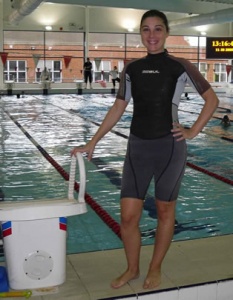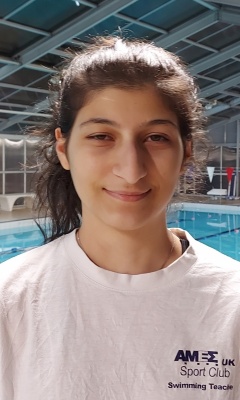Swim England NPTS Stages and Awards

Duckling Awards
The Duckling Awards are designed to help babies and toddlers explore and enjoy the fun of learning to swim. With the help of their parents/carers, the Duckling Awards support the National Plan for Teaching Swimming and help to develop and boost the confidence of very young children, both in and out of the water. Follow this link to read the full details of the Swim England “Ducking Awards”.
Swim England NPTS – Alpha Step
The Alpha Step Awards are a series of three awards that were created to maximise the potential and the enjoyment of all swimmers.
These provide small stepping stones for those individuals who may need additional support. The awards are particularly relevant for the shy/timid child, the tentative adult and some disabled individuals as they help to develop the early stages of buoyancy, coordination, spatial awareness, aquatic breathing, as well as entries and exits.
The scheme consists of basic water confidence and aquatic skills that once mastered, will enable a smooth transition for the learner into Stage 1 of the National Plan for Teaching Swimming.
Swim England NPTS – Rainbow Distance
The Rainbow Awards are bright, cheerful and motivating. They are designed to give young swimmers, aged five and older, the incentive to develop their swimming abilities and stamina.
This comprehensive collection of distance awards ranges from five metres with a buoyancy aid (Puffin) through to 5,000 metres. This range of awards is designed to motivate children to swim longer distances by increasing the distance gradually over the 19 Awards in the series. This helps young swimmers to develop their confidence, ability and stroke techniques along the way.
The Puffin Award and the Rainbow Awards have been very carefully designed to test, encourage and give swimmers the confidence to achieve their goals.
Swim England NPTS – National Plan
The National Plan for Teaching Swimming (NPTS – Powered by British Gas) is the national syllabus produced by the Swim England to assist and support the delivery of swimming lessons.
It is the most successful sports programme of its kind and the syllabus is currently being implemented in over 1,000 swimming programmes nationwide as well as being adopted overseas as a model of good practice.
The 10 Stages – Foundation
The British Gas Learn to Swim Programme takes the non-swimmer on a journey from the first splash to developing confidence and competence in the water.
There is a definite pathway to the British Gas Learn to Swim Programme, starting with the Foundation level, moving through the movement skill Stages 1-7 and culminating in the sport skill Stage 8-10.
Foundations
The swimmer’s “journey through aquatics” starts with Foundation, a programme for developing early-years water confidence, encouraged through sessions such as “adult and child” and pre-school sessions.
Emphasis is on the development of very basic motor skills and an introduction to water and the swimming environment through fun and games. Swim England Duckling Awards and Alpha Step Awards provide the appropriate rewards for this section.
The next stage of the journey takes a swimmer through FUNdamental Movement. This makes up Stages 1-7 of the British Gas Swim England Learn to Swim Programme.
Stage 1
This stage is concerned with developing basic safety awareness,
the “class” scenario, basic movement skills and water confidence
skills. Swimmers may use aids, such as arm bands, floats, etc.
To complete Stage 1 of the NPTS participants will be able to complete in comfort the following
skills (with or without aids, equipment or support):
- Enter the water safely
- Move forward for a distance of 5 metres
- Move backwards for a distance of 5 metres
- Move sideways for a distance of 5 metres
- Scoop the water and wash the face
- Be at ease with water showered from overhead
- Move into a stretched floating position using aids, equipment or support
- Regain an upright position from on the back with support
- Regain an upright position from on the front with support
- Push & glide in a horizontal position to or from a wall
- Take part in a teacher lead partner orientated game
- Demonstrate an understanding of pool rules
- Exit the water safely
(13 Outcomes)
Stage 2
This stage focuses on developing safe entries to the water,
including jumping in, basic floating, travel on the front and back up to
a distance of five metres, and rotating the body to regain an upright
position. Swimmers may use aids such as arm bands, floats, etc.
To complete Stage 2 of the NPTS participants will be able to complete in comfort the following
skills (with or without aids, equipment or support):
- Jump in from poolside safely
- Blow bubbles a minimum of 3 times rhythmically with nose and mouth submerged
- Regain an upright position from the back without support
- Regain an upright position from the front without support
- Push from wall & glide on the back
- Push from wall & glide on the front
- Travel on the front for 5 metres, aids or equipment may be used
- Travel on the back for 5 metres, aids or equipment may be used
- Perform a rotation from the front to back to gain an upright position
- Perform a rotation from the back to the front to gain an upright position
(10 outcomes)
Stage 3
Concerned with developing safe entries into the water –
including submersion – travel up to 10 metres on the front and back, and
progressing water safety knowledge and body rotation skills from the
previous Stage, Stage 3 also sees the swimmer being assessed without the
use of aids or support.
To complete Stage 3 of the NPTS participants will be able to complete in comfort the following
skills (without support):
- Jump in from the poolside and submerge
- Sink, push away from the wall on side and maintain a streamlined position
- Push & glide on the front with arms extended and log roll onto the back
- Push & glide on the back with arms extended and log roll onto the front
- Travel on the front, tuck to rotate around the horizontal axis to return on the back
- Fully submerge to pick up an object
- Answer correctly 3 questions on the ‘Water Safety Code’
- Travel 10 metres on the back
- Travel 10 metres on the front
(9 Outcomes)
Stage 4
This stage aids the learner in developing the understanding of
buoyancy through a range of skills. Also covered is refining kicking
techniques for all strokes. The swimmer also has to swim 10 metres to a
standard directed by the ASA.
To complete Stage 4, participants will be able to achieve in comfort the following skills:
- Demonstrate an understanding of buoyancy
- Perform a tuck float for 5 seconds
- Perform a sequence of changing shapes (min 3) while floating on the surface
- Push & glide from the wall to the pool floor
- Kick 10 metres Backstroke
- Kick 10 metres Frontcrawl
- Kick 10 metres Butterfly
- Kick 10 metres Breaststroke on the front
- Kick 10 metres Breaststroke on the back
- Perform on the back a head first sculling action for 5 metres in a horizontal position
- Travel on back and roll in one continuous movement onto front
- Travel on front and roll in one continuous movement onto back
- Swim 10 metres, own choice to ASA Expected Standards
(13 outcomes)
NB: Basic diving skills will be introduced at this stage
Stage 5
During this stage swimmers develop “watermanship” through
sculling and treading water skills and body complete rotation. They also
perform all strokes for a distance of 10 metres to a standard provided
by the Swim England within the Swim England Learn to Swim Framework.
To complete Stage 5, participants will be able to achieve in comfort, the following skills:
- Perform a horizontal stationary scull on the back
- Perform a feet first sculling action for 5 metres whilst horizontal on the back
- Perform a sculling sequence with a partner for 30-45 seconds to include a rotation
- Tread water for 30 seconds
- Perform 3 different shaped jumps into deep water
- Swim 10 metres Backstroke to Swim England Expected Standards
- Swim 10 metres Frontcrawl to Swim England Expected Standards
- Swim 10 metres Breaststroke to Swim England Expected Standards
- Swim 10 metres Butterfly to Swim England Expected Standards
- Perform a handstand and hold for a minimum of 3 seconds
- Perform a forward somersault, tucked, in the water
- Demonstrate an action for getting help
(12 Outcomes)
Stage 6
Developing effective swimming skills – including coordinated
breathing – across all strokes is the focus of this stage. Learners also
have to swim a distance of 25 metres using a stroke of the swimmer’s
choice. Children also learn about aspects of water safety and about
preparing properly for exercise.
To complete Stage 6 participants will be able to achieve in comfort, the following skills:
- Demonstrate an understanding of preparation for exercise
- Sink, push off on side from the wall, glide, kick and rotate into Backstroke
- Sink, push off on side from the wall, glide, kick and rotate into Frontcrawl
- Swim 10 metres with clothes on
- Swim Frontcrawl to Swim England Expected Standards to include at least six rhythmical breaths
- Swim Breaststroke to Swim England Expected Standards to include at least six rhythmical breaths
- Swim Butterfly to Swim England Expected Standards to include at least three rhythmical breaths
- Swim 25 metres, choice of stroke to Swim England Expected Standards
- Perform a ‘Shout & Signal’ rescue
- Perform a surface dive
- Exit the water without using the steps
(11 outcomes)
Stage 7
During this stage, children develop quality stroke techniques up to 100 metres incorporating the skills they have learned, and combine them to develop a linked routine. They also complete successfully an obstacle course that combines a variety of skills accomplished through stages 1-7.
Once the swimmer has developed the core range of skills
required to be confident, competent and safe in the water through stages
1-7, he or she can then take part in different aquatic disciplines
through stages 8-10.
To complete Stage 7, participants will be able to achieve in comfort, the following skills:
- Swim 50 metres Backstroke to Swim England Expected Standards
- Swim 50 metres Frontcrawl to Swim England Expected Standards
- Swim 50 metres Breaststroke to Swim England Expected Standards
- Swim 50 metres Butterfly to Swim England Expected Standards
- Perform a movement sequence of 1 minute duration, in a group of 3 or more, incorporating a number of the following skills:
- Sculling –head first, feet first; rotation – forward/backward somersault, log roll; floating – star on the front/back, tuck float, create own: Eggbeater – moving, lifting one or both arms out of the water, link skills with strokes and sculls
- Perform a sitting dive
- Swim 50 metres continuously using one stroke to Swim England Expected Standards
- Swim 200 metres using a minimum of 3 different strokes to Swim England Expected Standards
- Tread water using egg beater action for 30 seconds
- Complete an obstacle course (using minimum of 4 objects) with feet off the bottom throughout
(11 outcomes)
Stage 8-10
Once the swimmer has developed the core range of skills required to be confident, competent and safe in the water through stages 1-7 of the British Gas Learn to Swim Programme, he or she can then take part in different aquatic disciplines through stages 8-10.
These stages are called the FUNdamental Sport Skills of the British Gas Swim England Learn to Swim Programme. Disciplines available to swimmers are competitive swimming, diving, synchronised swimming, water polo and rookie lifesaving. Availability will depend on leisure facility, so check with your local provider.
Stages 8, 9 and 10 of the British Gas Swim England Learn to Swim Programme are discipline specific and have synergy with the grass roots programmes developed by the disciplines to support the individual sports.
For the competitive swimming discipline in Stages 8, 9 and 10 Swim England has developed awards specifically to support the British Gas Swim England Learn to Swim Programme.
Swim England and the Royal Life Saving Society (RLSS) have
worked closely to develop Stages 8, 9 and 10 and to produce awards that
link into the British Gas Swim England Learn to Swim Programme.
To complete Stage 8, participants will be able to achieve in comfort, the following skills:
- Complete a set lasting 400m(e.g. 16 x 25m) on a specified turn around time set by the coach
- Swim 400 metres continuously using one stroke
- Kick 25 metres Backstroke with/without using a board
- Kick 25 metres Breaststroke with/without using a board
- Kick 25 metres Butterfly with/without using a board
- Kick 25 metres Frontcrawl with/without using a board
- Perform a Backstroke turn from 10 metres in to 15 metres out to Swim England Expected Standards
- Perform a Breaststroke turn from 10 metres in to 15 metres out to Swim England Expected Standards
- Perform a Butterfly turn from 10 metres in to 15 metres out to Swim England Expected Standards
- Perform a Frontcrawl turn from 10 metres in to 15 metres out to Swim England Expected Standard
(10 outcomes)
To complete Stage 9, participants will be able to achieve in comfort, the following skills:
- Complete a set lasting 800m(e.g. 4 x 200m) on a specified turn around time set by the coach
- Swim 800 metres continuously using one stroke
- Swim a continuous 100 metre Individual Medley using legal turns
- Perform a 15 metre underwater kick on the front in a streamlined position
- Perform a Backstroke start with butterfly kick underwater until 10 metres from the start point and complete remainder of the 25 metres
- Perform a Frontcrawl start underwater kick until 10 metres from the start point and complete the remainder of the 25 metres
- Perform a Butterfly start underwater kick until 10 metres from the start point and complete the remainder of the 25 metres
- Perform a Breaststroke start with 1 pull, 1 Butterfly kick and 1 Breaststroke kick underwater and complete remainder of the 25 metres.
(8 outcomes)
To complete Stage 10, participants will be able to achieve in comfort, the following skills:
- Complete a set lasting 1600m(e.g. 8 x 200m) on a specified turn around time set by the coach
- Swim 1500 metres continuously using one stroke
- Perform a continuous 100 metre Individual Medley kick using a kickboard
- Swim a continuous 200 metre Individual Medley using legal turns
- Perform a 15 metre underwater Butterfly kick on the back or front in a streamlined position
- Perform a Frontcrawl relay takeover as an oncoming swimmer
- Perform a Frontcrawl relay takeover as an outgoing swimmer
(7 outcomes)
Swim England NPTS – Pre Competition Development
These two levels of award help to develop the skill and confidence needed for those who want to enter swimming competitions – and succeed. The focus is initially on revising and consolidating the efficient performance of the four competitive strokes and the racing skills associated with them.
The awards lay the foundations for young swimmers who want to attend the coaching and training programmes which would prepare them for competitive swimming. The awards are designed to help with stroke development, kicking, turns and using a pace clock. Once the standard of stroke and skill performance has been achieved, the final stages introduce the more demanding aspects of training development and can be undertaken with confidence.
Swim England NPTS – Swimming Challenge
With this range of awards, pupils are challenged to achieve specified targets using a wide range of skills and stamina proficiently. Throughout this scheme all strokes should be in good style. This implies that the stroke is easily recognisable as one of the four major competitive strokes but does not necessarily comply with Swim England law. The strokes should be co-ordinated, smooth, efficient and completed without undue stress.
To celebrate the achievement reached in each of the Swimming Challenge Awards Categories, you may also wish to purchase the accompanying enamel lapel pin.







